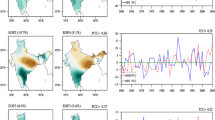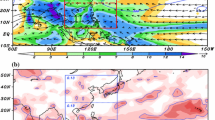Abstract
Northwest China (NWC) is an arid and semi-arid region where climate variability and environmental changes are sensitive to precipitation. The present study explores sources and limits of predictability of summer precipitation over NWC using the predictable mode analysis (PMA) of percentage of rainfall anomaly data. Two major modes of NWC summer rainfall variability are identified which are tied to Eurasian continental scale precipitation variations. The first mode features wet northern China corresponding to dry central Siberia and wet Mongolia, which is mainly driven by tropical Pacific sea surface temperature anomalies (SSTA). The second mode features wet western China reflecting wet Central Asia and dry Ural–western Siberia, which strongly links to Indian Ocean SSTA. Anomalous land warming over Eurasia also provides important precursors for the two modes. The cross-validated hindcast results demonstrate these modes can be predicted with significant correlation skills, suggesting that they may be considered as predictable modes. The domain averaged temporal correlation coefficient (TCC) skill during 1979 to 2015 using 0-month (1-month) lead models is 0.39 (0.35), which is considerably higher than dynamical models’ multi-model ensemble mean skill (−0.02). Maximum potential attainable prediction skills are also estimated and discussed. The result illustrates advantage of PMA in predicting rainfall over dry land areas and large room for dynamical model improvement. However, secular changes of predictors need to be detected continuously in order to make practical useful prediction.









Similar content being viewed by others
References
Madec GP et al (1998) OPA version 8.1, Ocean general circulation model reference manual. LODYC Technical Report No. 11, Paris
Chen LX, Dong M, Shao YN (1992) The characteristics of interannual variations of the East Asian Monsoon. J Meteor Soc Jpn 70:397–421
Dee DP et al (2011) The ERA-interim reanalysis: configuration and performance of the data assimilation system. Q J R Meteorol Soc 137(656):553–597
Delworth TL et al (2006) GFDL’s CM2 global coupled climate models. Part I: formulation and simulation characteristics. J Clim 19:643–674
Deque M (2004) Seasonal predictability of tropical rainfall: probabilistic formulation and validation. Tellus 53(4):500–512
Ding QH, Wang B (2005) Circumglobal teleconnection in the Northern Hemisphere Summer. J Clim 18:3483–3505
FAO, Unesco, WMO (1977) World map of desertification. Food and Agricultural Organization, Rome
Gong DY, Shi PJ, Wang JA (2004) Daily precipitation changes in the semi-arid region over northern China. J Arid Environ 59(4):771–784
Gregory D et al (2000) Revision of convection, radiation and cloud schemes in the ECMWF Integrated Forecasting System. Q J R Meteorol Soc 126:1685–1710
Guo QY, Wang J (1988) A comparative study on summer monsoon in China and India. J Tropical Meteorol 4:53–60 (in Chinese with English abstract)
Huang B et al (2014) Extended reconstructed sea surface temperature version 4 (ERSST.v4): Part I. Upgrades and intercomparisons. J Clim 28(3):911–930
Huang W, Feng S, Chen J et al (2015) Physical mechanisms of summer precipitation variations in the Tarim basin in Northwestern China. J Clim 28(9):3579–3591
Huffman GJ, Bolvin DT, Adler RF (2011) Last updated GPCP version 2.2 combined precipitation data set. WDC-A, NCDC, Asheville, NC. http://www.ncdc.noaa.gov/oa/wmo/wdcamet-ncdc.html
Jungclaus JH et al (2006) Ocean circulation and tropical variability in the coupled model ECHAM5/MPI-OM. J Clim 19:3952–3972
Kripalani RH, Singh SV (1993) Large scale aspects of India–China summer monsoon rainfall. Adv Atmos Sci 10:71–84
Lee JY (2013) Seasonal prediction and predictability of the Asian winter temperature variability. Clim Dyn 41:573–587
Lee JY et al (2011) How predictable is the Northern Hemisphere summer upper-tropospheric circulation? Clim Dyn 37:1189–1203
Li J, Wang B (2015) How predictable is the anomaly pattern of the Indian summer rainfall? Clim Dyn. doi:10.1007/s00382-015-2735-6
Liu W (2014) Extended reconstructed sea surface temperature version 4 (ERSST.v4): Part II. Parametric and structural uncertainty estimations. J Clim 28(3):931–951
Luo JJ et al (2005) Seasonal climate predictability in a coupled OAGCM using a different approach for ensemble forecast. J Clim 18:4474–4497
Lv TZ, Deng SG, Hu YJ, Zhang K (2015) Quantitative prediction of precipitation in the east of northwest china during the flood period by using the year-to-year increment approach. J Arid Meteorol 33(3):386–394 (in Chinese with English abstract)
Madec GP et al (1997) OPA release 8, Ocean general circulation model reference manual. LODYC Internal Report, Paris
Marsland SJ et al (2003) The Max Planck Institute global ocean/sea ice model with orthogonal curvilinear coordinates. Ocean Model 5:91–127
Michaelsen J (1987) Cross-validation in statistical climate forecast models. J Clim Appl Meteor 26(11):1589–1600
Molteni F et al (2011) The new ECMWF seasonal forecast system (System 4). ECMWF Tech Memorandum 656:1–49
North GR, Bell TL, Cahalan RF, Moeng FJ (1982) Sampling errors in the estimation of empirical orthogonal functions. Mon Wea Rev 110(7):699–706
Panofsky HA, Brier GW (1968) Some application of statistics to meteorology. Pennsylvania State University Press, University Park, PA
Roeckner E (1996) The atmospheric general circulation model ECHAM4: model description and simulation of presentday climate. Max Planck Institut fur Meteorologie, Report No. 218, Hamburg, Germany
Saha S et al (2014) The NCEP climate forecast system version 2. J Clim 27:2185–2208
Samel AN, Wang WC, Liang XZ (1999) The monsoon rainband over China and relationships with the Eurasian circulation. J Clim 12:115–131
Shen S, Lau KM (1995) Biennial oscillation associated with the East Asian summer monsoon and tropical sea surface temperature. J Meteor Soc Jpn 73:105–123
Wang WC, Li K (1990) Precipitation fluctuation over semi-arid region in Northern China and the relationship with El Nino/Southern Oscillation. J Clim 3:769–783
Wang B, Zhang Q (2002) Pacific-East Asian teleconnection, Part II: how the Philippine Sea anticyclone established during development of El Nino. J Clim 15:3252–3265
Wang B, Wu R, Fu X (2000) Pacific-East Asia teleconnection: how does ENSO affect East Asian climate? J Clim 13:1517–1536
Wang B, Lee JY, Kang IS, Shukla J, Hameed SN, Park CK (2007) Coupled predictability of seasonal tropical precipitation. CLIVAR Exchanges 12:17–18
Wang B, Liu J, Yang J, Zhou T, Wu Z (2009a) Distinct principal modes of early and late summer rainfall anomalies in East Asia. J Clim 22:3864–3875
Wang B et al (2009b) Advance and Prospect of Seasonal Prediction: assessment of the APCC/CliPAS 14-model ensemble retroperspective seasonal prediction (1980-2004). Clim Dyn 33:93–117
Wang B, Xiang B, Lee JY (2013) Subtropical high predictability establishes a promising way for monsoon and tropical storm predictions. PNAS 10:2718–2722
Wang B, Lee JY, Xiang BQ (2014) Asian summer monsoon rainfall predictability: a predictable mode analysis. Clim Dyn 44:1–14
Wu ZW, Yu LL (2016) Seasonal prediction of the East Asian summer monsoon with a partial-least square model. Clim Dyn 46:3067–3078
Wu ZW, Wang B, Li JP, Jin FF (2009) An empirical seasonal prediction model of the East Asian summer monsoon using ENSO and NAO. J Geophys Res 114:D18120. doi:10.1029/2009JD011733
Xing W, Wang B, Yim S-Y (2016a) Peak-summer East Asian rainfall predictability and prediction part I: Southeast Asia. Clim Dyn 47:1–13
Xing W, Wang B, Yim S-Y (2016b) Long-lead seasonal prediction of china summer rainfall using an EOF–PLS regression-based methodology. J Clim 29(5):1783–1796. doi:10.1175/jcli-d-15-0016.1
Yasunari T (1990) Impact of Indian monsoon on the coupled atmosphere/ocean system in the tropical Pacific. Meteor Atmos Phys 44:29–41
Yatagai A, Yasunari T (1995) Interannual variations of summer precipitation in the arid/semi-arid regions in China and Mongolia: their regionality and relation to the Asian summer monsoon. J Meteor Soc Jpn 73:909–923
Ye DZ, Chen PQ (1992) Global change in China: a preliminary study. Meteorological Press, Beijing In Chinese
Yim SY, Wang B, Xing W (2014) Peak-summer east asian rainfall predictability and prediction Part II: extratropical East Asia. Clim Dyn 89–98
Zhao CG, Li ZC (2013) Regional modeling forecast of precipitation in summer in Northwest China. J Desert Res V 33(5):1544–1551 (in Chinese with English abstract)
Zhong AH, Hendon H, Alves O (2005) Indian Ocean variability and its association with ENSO in a global coupled model. J Clim 18:3634–3649
Acknowledgments
The work was supported by the Global Change Research Program of China (2015CB953904, 2012CB955604) and National Natural Science Foundation of China (No. 41575067). This work was also supported by Atmosphere–Ocean Research Center that is sponsored by Nanjing University of Information Science and Technology. We also acknowledge support from the International Pacific Research Center (IPRC). This is publication No 9830 of the SOEST, publication No 1213 of IPRC and publication No 128 of Earth System Modeling Center (ESMC).
Author information
Authors and Affiliations
Corresponding author
Rights and permissions
About this article
Cite this article
Xing, W., Wang, B. Predictability and prediction of summer rainfall in the arid and semi-arid regions of China. Clim Dyn 49, 419–431 (2017). https://doi.org/10.1007/s00382-016-3351-9
Received:
Accepted:
Published:
Issue Date:
DOI: https://doi.org/10.1007/s00382-016-3351-9




